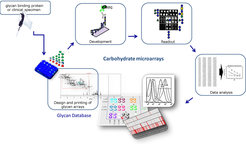Carbohydrate microarrays
Most oligo- and polysaccharides are cell surface carbohydrates or part of the extracellular matrix. Cell-surface sugars are either part of the protective layer that protects cells from physical damage or regulate interactions of cells with the environment. Thus, carbohydrates are involved in most cell–cell interactions, cell motility and cell signaling processes. The identification of specific carbohydrate structures responsible for a particular function is an essential first step for glycomics investigations.
Carbohydrate microarrays have become powerful tools to study binding events involving sugars, especially as a means to perform many low-cost high-throughput analyses of carbohydrate interactions with a wide variety of biological targets including proteins, nucleic acids, whole viruses and cells. Binding preferences, inhibition of interactions, enzyme activities and structure-function relationships can be determined. Screening and characterization of antibodies as well as the identification of biomarkers can be conducted efficiently with glycan microarray.
A comprehensive glycan database comprised of unique mammalian and microbial glycans has been established in-house. The database contains different bacterial lipopolysaccharides, capsular polysaccharides, glycosaminoglycans, surface oligosaccharides and many other carbohydrate antigens. We routinely screen clinical specimens and glycan-binding proteins to assess the diagnostic potential of glycan biomarkers.

